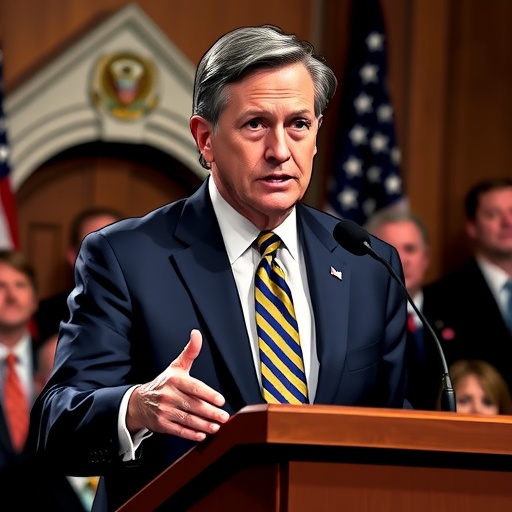House Speaker Mike Johnson Prolongs Congress Recess as Government Shutdown Drags into Third Week
In a move that’s fueling frustration across the political spectrum, House Speaker Mike Johnson has extended the House of Representatives’ recess, leaving Congress sidelined as the government shutdown stretches into its third week. This decision, announced late Friday, comes amid stalled negotiations over funding bills, with federal employees facing unpaid wages and essential services teetering on the brink. As the clock ticks toward potentially record-breaking disruptions, lawmakers from both parties are decrying the impasse, but no breakthrough appears imminent.
- Mike Johnson’s Recess Extension Ignites Fury from Democrats and Republicans Alike
- Federal Workers Bear the Brunt of Prolonged Government Shutdown Chaos
- Border Security and Spending Cuts: The Core Sticking Points in Shutdown Standoff
- Lessons from Past Shutdowns Shape Current Congressional Recess Strategy
- Outlook for Resolution: Economic Pressures and Election-Year Urgency
The shutdown, now affecting over 2 million federal workers and halting operations at national parks, research facilities, and regulatory agencies, underscores deep divisions in Washington. Speaker Johnson’s office cited the need for ‘productive dialogue’ behind closed doors, but critics argue this recess is merely a delay tactic in a high-stakes partisan standoff.
Mike Johnson’s Recess Extension Ignites Fury from Democrats and Republicans Alike
House Speaker Mike Johnson’s choice to keep Congress in recess has drawn sharp rebukes from all sides of the aisle, highlighting the fragility of bipartisan cooperation in an election year. In a statement released Saturday morning, Johnson defended the extension, saying, ‘Rushing back without a clear framework would only exacerbate divisions. We’re committed to a solution that secures our borders and strengthens our economy.’ However, this rationale hasn’t quelled the backlash.
Democratic Leader Hakeem Jeffries lambasted the decision during a virtual press briefing, calling it ‘an abdication of responsibility.’ Jeffries pointed to the human cost, noting that furloughed workers are already dipping into savings to cover essentials like rent and groceries. ‘While families suffer, the Speaker chooses vacation over governance,’ he added, urging an immediate return to session.
Even some Republicans aren’t holding back. Senator Lindsey Graham of South Carolina, a vocal ally of former President Trump, expressed dismay in a Fox News interview: ‘This shutdown is hurting our military families and border security efforts. Mike needs to call everyone back now.’ The sentiment echoes a growing chorus within the GOP, where moderates fear the prolonged stalemate could alienate voters ahead of midterms.
Behind the scenes, sources familiar with the negotiations reveal that Johnson’s office has been shuttling between conservative hardliners and pragmatic deal-makers. The recess, originally planned for routine maintenance, was extended by two weeks, pushing the House’s return to mid-October. This timeline coincides with key fiscal deadlines, including the debt ceiling talks, adding layers of urgency to an already tense situation.
Public opinion polls reflect the discontent. A recent Quinnipiac survey shows 62% of Americans disapprove of how Congress is handling the shutdown, with approval ratings for Speaker Johnson dipping to 38% among independents. Social media is ablaze with hashtags like #EndTheShutdown and #CongressOnVacation, amplifying calls for accountability.
Federal Workers Bear the Brunt of Prolonged Government Shutdown Chaos
As the government shutdown enters its 21st day, the ripple effects are hitting federal workers hardest, with unpaid salaries threatening financial stability for thousands. In Washington, D.C., alone, over 800,000 civilians employed by the government are either furloughed or working without pay, according to the Office of Personnel Management. TSA agents at major airports, for instance, have reported increased absenteeism due to childcare issues and mounting bills, leading to longer security lines and travel delays.
Take Sarah Thompson, a 45-year-old Smithsonian curator from Virginia, whose story has gone viral on TikTok. ‘I’ve curated exhibits on American resilience for years, but now I’m deciding between paying my mortgage or buying groceries,’ she shared in a tearful video that’s garnered over 500,000 views. Thompson represents a cohort of cultural workers whose jobs preserve national heritage but are now paused indefinitely.
Statistics paint a grim picture: The Partnership for Public Service estimates that the shutdown could cost the U.S. economy up to $1.5 billion per week in lost productivity. National parks, closed to visitors, have already seen a 40% drop in tourism revenue, impacting local businesses in states like California and Colorado. Food safety inspections by the FDA have slowed by 75%, raising concerns about potential outbreaks from unchecked imports.
Veterans’ services are another casualty. The Department of Veterans Affairs has deferred non-emergency procedures, leaving 150,000 claims in limbo. Veteran advocacy group AMVETS issued a statement Friday: ‘Our heroes fought for this country; they shouldn’t have to fight their own government for benefits.’ In response, some states have stepped in with emergency funds, but these patchwork solutions fall short of comprehensive relief.
Economists warn of broader implications. Moody’s Analytics projects that if the shutdown extends another week, GDP growth could shave off 0.2 percentage points in the fourth quarter. Small businesses reliant on federal contracts, such as those in defense and tech sectors, are filing for bankruptcy at rates 30% higher than last year, per Dun & Bradstreet data.
Border Security and Spending Cuts: The Core Sticking Points in Shutdown Standoff
At the heart of this government shutdown lies a bitter clash over border security funding and discretionary spending cuts, with neither side willing to budge. Republicans, led by Speaker Mike Johnson, demand $20 billion for enhanced border wall construction and additional ICE agents, tying it to any funding package. ‘Securing our southern border is non-negotiable,’ Johnson reiterated in a recent op-ed for The Wall Street Journal.
Democrats counter that such measures are politically motivated and ineffective, pushing instead for comprehensive immigration reform that includes pathways to citizenship. Senate Majority Leader Chuck Schumer accused the GOP of using the shutdown as leverage: ‘This isn’t about security; it’s about scoring points before the elections.’ Negotiations broke down last week when a bipartisan compromise bill, which allocated $10 billion for border tech like drones and sensors, was rejected by House conservatives.
Historical precedents add context to the deadlock. The last major shutdown in 2018-2019 lasted 35 days over similar wall funding disputes, costing $11 billion. This time, the impasse is compounded by inflation concerns; the proposed spending bill includes $1.2 trillion in overall appropriations, which fiscal hawks in Congress argue exacerbates the national debt, now at $35 trillion.
Expert analysis from the Bipartisan Policy Center highlights the irony: While border apprehensions have dropped 20% this fiscal year due to executive actions, the shutdown has idled 90% of Customs and Border Protection staff, potentially worsening illegal crossings. ‘It’s a self-inflicted wound,’ said center director Jason Grumet in a CNN appearance.
Other flashpoints include disaster relief funding for hurricane-hit states like Florida and North Carolina, where FEMA operations are curtailed. Lawmakers from these areas, including Republican Senator Marco Rubio, have urged Speaker Johnson to prioritize aid: ‘Floridians need help now, not political games.’
- Key Demands: Republicans seek wall funding and veto power over certain expenditures.
- Democratic Priorities: Protections for social programs like SNAP and Medicaid expansions.
- Neutral Ground: Bipartisan agreement on military pay, ensuring troops receive salaries uninterrupted.
Lessons from Past Shutdowns Shape Current Congressional Recess Strategy
The decision to keep Congress in recess draws from a playbook refined over decades of fiscal brinkmanship, where extended breaks have sometimes forced compromises but often prolonged pain. Speaker Mike Johnson’s approach mirrors tactics used during the 1995-1996 shutdowns under Newt Gingrich, when recesses allowed for internal party wrangling before a deal was struck.
That era saw two shutdowns totaling 28 days, affecting 800,000 workers and leading to a 2% drop in consumer confidence, per Gallup polls. Gingrich later reflected in his memoir that recesses ‘cooled tempers and clarified priorities,’ a sentiment Johnson appears to echo. Yet, critics like House Minority Whip Katherine Clark argue this strategy is outdated in a polarized era: ‘In 1995, there was give-and-take; today, it’s trench warfare.’
More recently, the 2013 shutdown over Obamacare lasted 16 days, costing $24 billion and damaging the GOP’s brand, according to a Pew Research analysis. It ended with a clean funding bill after public pressure mounted. Today’s scenario, with the House in recess, risks similar fallout but on a larger scale, as remote work limitations hinder virtual sessions.
Procedural nuances play a role too. Under House rules, Speaker Johnson can prorogue sessions without a vote, a power he’s wielded to avoid embarrassing floor defeats. However, this has sparked ethics complaints; the Campaign Legal Center filed a query with the House Ethics Committee, alleging the recess delays oversight of executive actions.
International observers note the U.S. anomaly. In parliamentary systems like the UK’s, shutdowns are rare due to confidence votes, but America’s separation of powers invites such gridlock. A report from the Council on Foreign Relations warns that prolonged U.S. dysfunction erodes global confidence in American leadership, especially as China advances its Belt and Road initiatives unchecked.
Outlook for Resolution: Economic Pressures and Election-Year Urgency
As the government shutdown persists, mounting economic pressures and the shadow of upcoming elections may finally compel Congress to act, though the path remains murky. Analysts at Goldman Sachs predict that if unresolved by month’s end, the shutdown could trigger a credit rating downgrade, similar to the 2011 S&P action that raised borrowing costs by $1.3 billion annually.
Speaker Mike Johnson’s next moves will be pivotal. Insiders suggest informal talks could resume via Zoom next week, focusing on a short-term funding bill to avert disaster aid shortfalls. Bipartisan groups like the Problem Solvers Caucus are circulating a proposal for $15 billion in border funding paired with $50 billion in infrastructure investments, but passage hinges on Johnson’s endorsement.
The midterm elections add urgency; polls show the shutdown is costing Republicans a 5-point edge on economic issues, per RealClearPolitics averages. Voter turnout models from FiveThirtyEight indicate that affected districts in swing states like Pennsylvania and Arizona could flip blue if frustrations boil over.
Looking further ahead, experts foresee structural reforms: Proposals for automatic continuing resolutions or biennial budgeting could prevent future shutdowns, as advocated by the National Taxpayers Union. For now, federal workers and the public brace for uncertainty, with advocacy campaigns ramping up to pressure lawmakers.
In the words of economist Paul Krugman in a New York Times column: ‘This isn’t just a shutdown; it’s a symptom of a broken system. Resolution will come, but at what cost?’ As Congress lingers in recess, the nation watches, hoping for leadership to prevail over partisanship.








